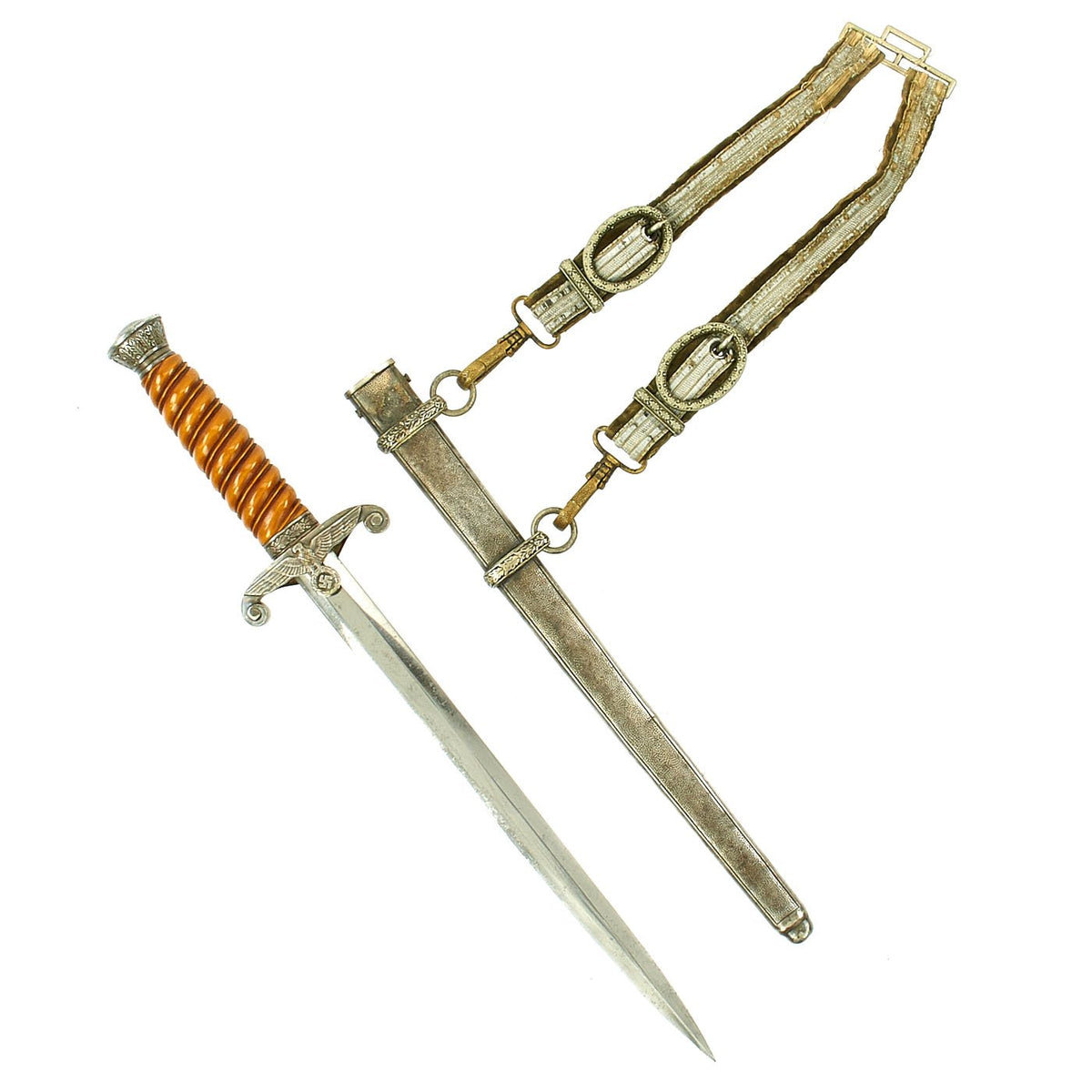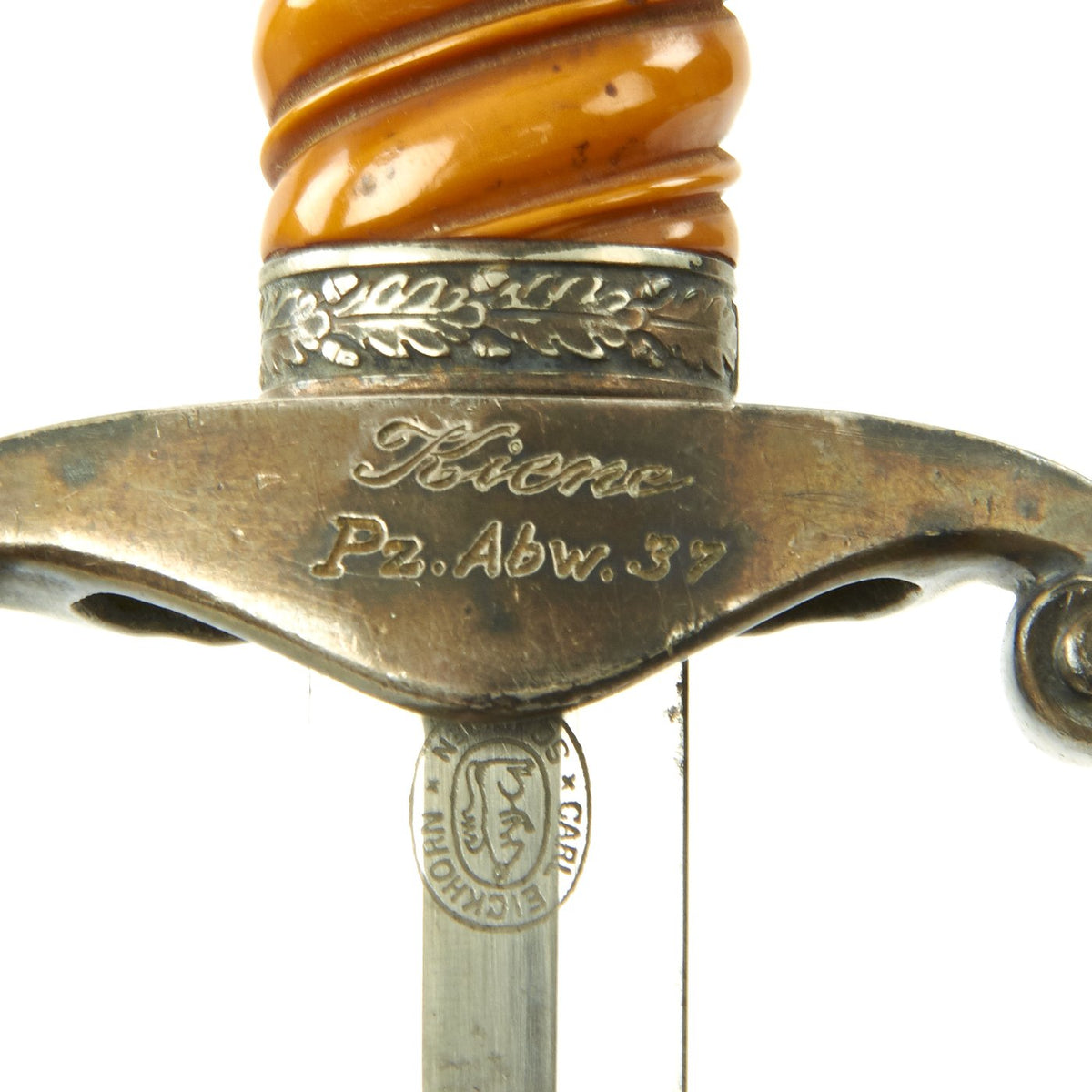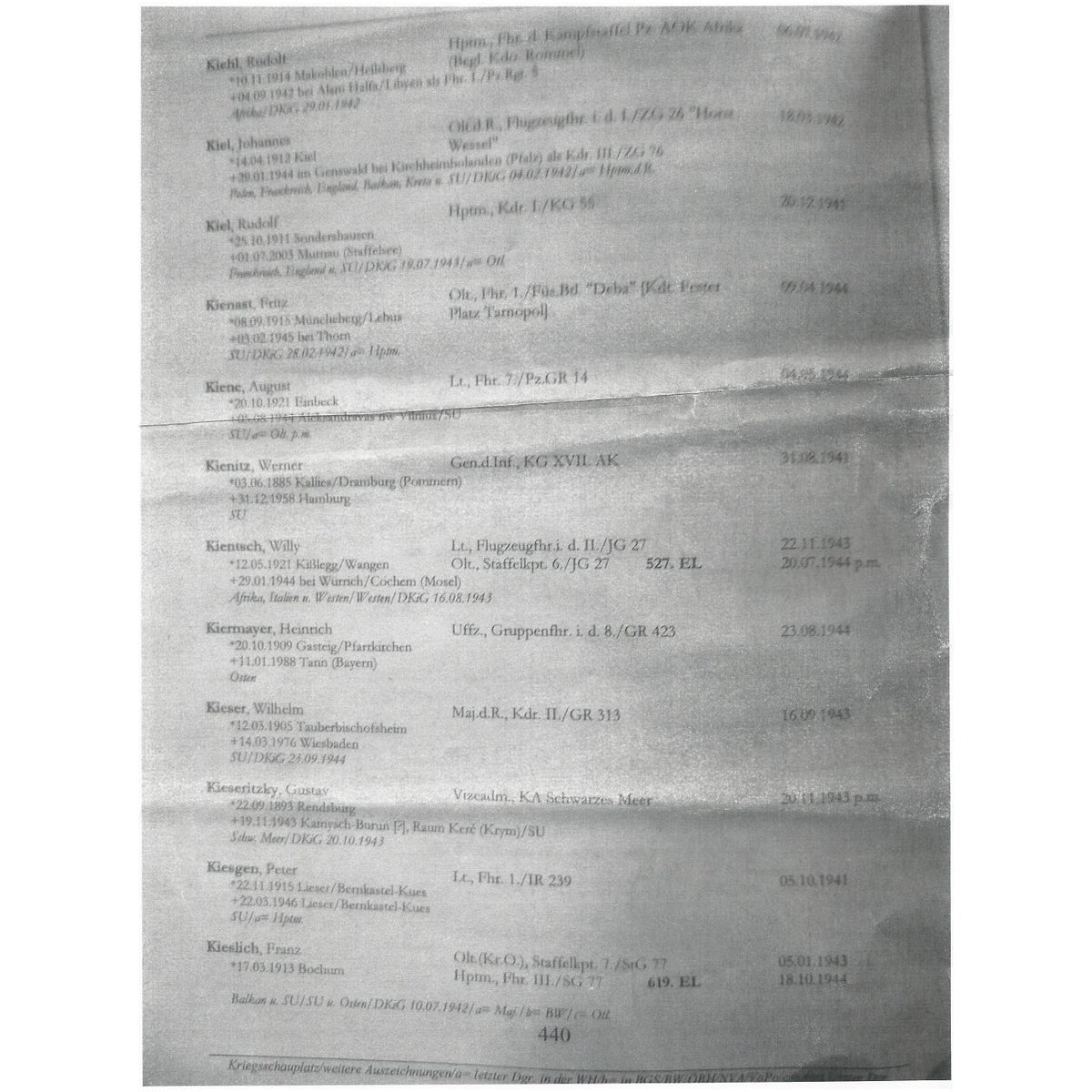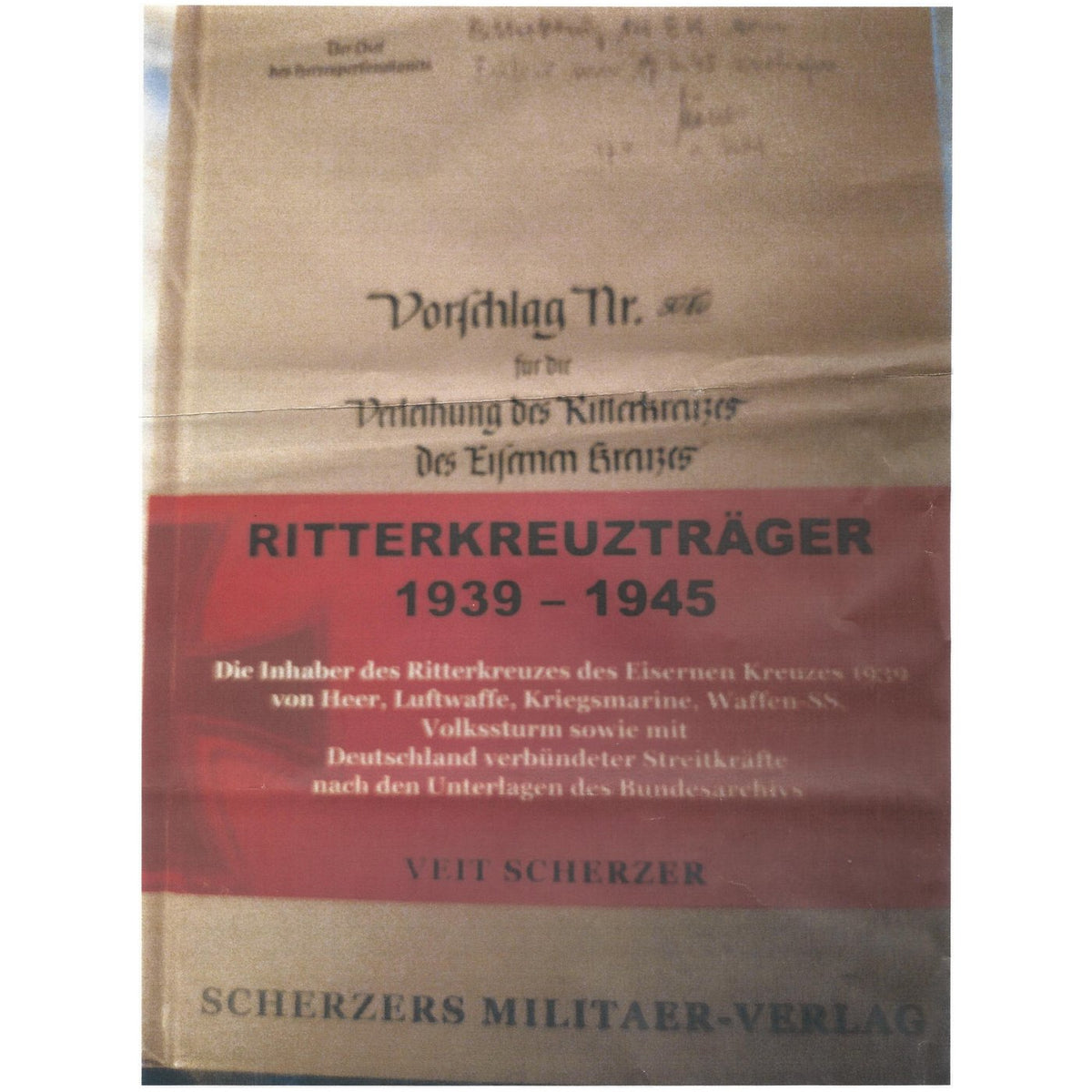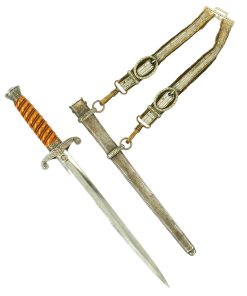Original German WWII Army Heer Officer Dagger by Carl Eickhorn named to Knight’s Cross Recipent A. Kiene Original Items
$ 1.695,00 $ 423,75
Original Item: Only One Available. This is an incredible offering, something we’ve never had before! This is a very nice Army Officer’s Dagger, produced by the legendary Solingen-based firm Carl Eickhorn. These alone are desirable, however on the cross guard it has been personalized quite nicely:
Kienne
Pz. Abw. 37
Research shows that this dagger was last owned by August Kiene, born 20 October 1921 in Einbeck. His name is on the list of Ritterkreuzträger, or people who were awarded the very prestigious Ritterkreuz des Eisernen Kreuzes (Knight’s Cross of the Iron Cross), usually referred to as the Knight’s Cross (Ritterkreuz). The records list him as a Lt., Fhr. 7./Pz.GR 14 and that he was awarded the Knight’s Cross on 04.05.1944 (May 4th 1944). The records also indicate that he was killed 05.08.1944 in Alexandravas nw Vilnius.
Only 7,000 servicemen were awarded these during the war, out of over 13 million. Finding militaria linked to one of these is extremely rare. This really is a fantastic find, and includes printouts from the book where his name was located. Unfortunately the pictures are somewhat low quality, but still legible.
The pommel of this dagger is in very good condition, showing a little wear and scratching throughout the bottom, but nothing bad. Some of the plating has worn away, and this appears to be a dagger that was worn often.
The silver plated nickel crossguard is in better condition, with a lot of the plating intact, with a great patina. The name and regiment have been engraved quite well. The details throughout the characteristic Carl Eickhorn eagle are exceptional throughout the head, breast and wing feathering, talons and wreathed mobile swas. The grip ferrule is also silver-plated, and is in good condition with minimal wear.
The grip is has faded to a nice deep orange, typical of celluloid grips from this period. This grip is in almost perfect condition throughout, with just a bit of staining and wear.
The very nice blade is mostly bright throughout, though it definitely has been cleaned several times, so the original cross grain is faint. There are a few areas where light staining can be seen, and there is also the expected runner wear. This was a dagger that was in service for around a decade, and in light of that it is in great shape.
The reverse ricasso is etched with the 1933-35 Eickhorn trademark: a double oval “losenge” style with a seated squirrel, with CARL EICKHORN above and SOLINGEN marked below. Per J. Anthony Carter’s book GERMAN KNIFE AND SWORD MAKERS, this firm used this specific trademark on heer daggers during the Pre-WWII Period until 1935. The original leather blade buffer is in place within the deep recesses of the guard.
The scabbard is a fine Carl Eickhorn example, and is silver plated nickel alloy. This scabbard has very crisp, finely grained panels, with a few dents as shown. The carrying bands have an excellent pattern of overlapping oak leaves and acorns, which are nicely enhanced, but do show service wear. The throat is the thinner style, and has a single securing screws on the thin sides of the scabbard. It has a lovely oxidized look. There is not really any flaking we can see, making this a great example.
Attached to the scabbard is a good condition belt hanger, with functional pebbled spring clips with a great patina. The buckles and keepers are engraved with the same oak and acorn motif seen throughout the dagger. This is a hanger that was used quite extensively, with wear on both sides of the straps.
A really nice German Heer dagger, named to a recipient of the Knight’s Cross, something we are unlikely to have again anytime soon. Ready to display!
German Army Daggers
The German Army (Heer) first carried a dagger beginning in 1935. The weapon was worn in lieu of occasions not demanding the wearing of a more formal sword. The dagger design was quite attractive featuring silvered heavy fittings with white or colored grip. The crossguard depicted a Wehrmacht open-winged eagle clutching a wreathed swas.
The pommel depicted oak leafing around the outer circumference. The scabbard had panels of pebble designs. Later produced examples were plated with nickel, and late war-made pieces were unplated, finished in a gray color metal. These daggers are often encountered with an aluminum portepee.
The Knight’s Cross of the Iron Cross (German: Ritterkreuz des Eisernen Kreuzes), or simply the Knight’s Cross (Ritterkreuz), and its variants were the highest awards in the military and paramilitary forces of NSDAP Germany during World War II.
The Knight’s Cross of the Iron Cross
The Knight’s Cross was awarded for a wide range of reasons and across all ranks, from a senior commander for skilled leadership of his troops in battle to a low-ranking soldier for a single act of military valour. Presentations were made to members of the three military branches of the Wehrmacht: the Heer (army), the Kriegsmarine (navy) and the Luftwaffe (air force), as well as the Waffen-SS, the Reichsarbeitsdienst (RAD—Reich Labour Service) and the Volkssturm (German national militia), along with personnel from other Axis powers.
The award was instituted on 1 September 1939, at the onset of the German invasion of Poland. A higher grade, the Oak Leaves to the Knight’s Cross, was instituted in 1940. In 1941, two higher grades of the Knight’s Cross with Oak Leaves were instituted: the Knight’s Cross with Oak Leaves and Swords and the Knight’s Cross with Oak Leaves, Swords and Diamonds. At the end of 1944 the final grade, the Knight’s Cross with Golden Oak Leaves, Swords and Diamonds, was created. Over 7,000 awards were made during the course of the war.
Fast Shipping with Professional Packaging
Thanks to our longstanding association with UPS FedEx DHL, and other major international carriers, we are able to provide a range of shipping options. Our warehouse staff is expertly trained and will wrap your products according to our exact and precise specifications. Prior to shipping, your goods will be thoroughly examined and securely secured. We ship to thousands clients each day across multiple countries. This shows how we're dedicated to be the largest retailer on the internet. Warehouses and distribution centres can be located throughout Europe as well as the USA.
Note: Orders with more than one item will be assigned a processing date depending on the item.
Before shipping before shipping, we'll conduct a thorough inspection of the items you have ordered. Today, the majority of orders will be delivered within 48 hours. The delivery time will be between 3-7 days.
Returns
The stock is dynamic and we cannot completely manage it because multiple stakeholders are involved, including our factory and warehouse. So the actual stock may alter at any time. It's possible that you may not receive your order once the order has been made.
Our policy is valid for a period of 30 days. If you don't receive the product within 30 days, we are not able to issue a refund or an exchange.
You can only return an item if it is unused and in the same state as the day you received it. You must have the item in its original packaging.
Related products
Uncategorized
Uncategorized
Uncategorized
Uncategorized
Uncategorized
Armoured Fighting Vehicles of the World: AFVs of World War One (Hardcover Book) New Made Items
Uncategorized
Uncategorized
Uncategorized
Uncategorized
Australian WWII Owen MK1 Machine Carbine SMG Custom Fabricated Replica with Sling Original Items
Uncategorized
Uncategorized
Uncategorized
Band of Brothers ORIGINAL GERMAN WWII Le. F.H. 18 10.5cm ARTILLERY PIECE Original Items
Uncategorized
Uncategorized
Uncategorized
Uncategorized
Uncategorized
Armored Burgonet Helmet & Polearm from Scottish Castle Leith Hall Circa 1700 Original Items
